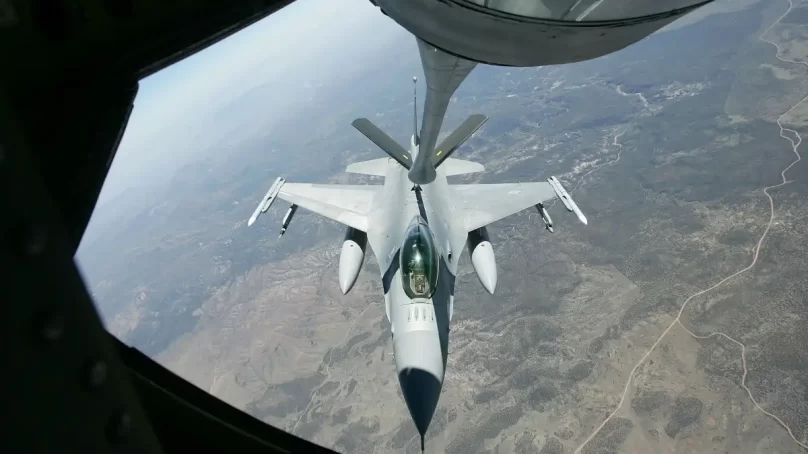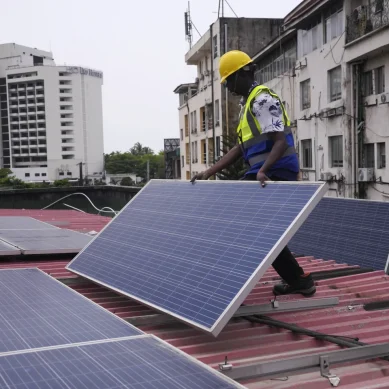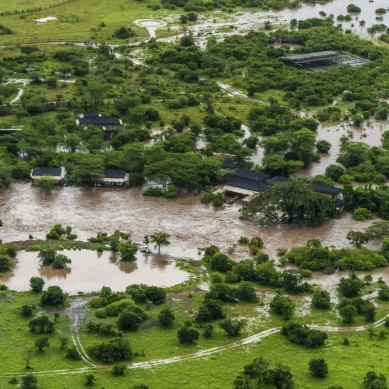
The world’s militaries are heavy emitters of greenhouse gases. No one knows exactly how much. Estimates range between one percent and five per cent of global emissions, comparable with the aviation and shipping industries (two per cent each).
Yet militaries are largely spared from emissions reporting. This must change, or mitigation measures risk becoming mere guesswork.
For instance, the US military is the world’s largest in terms of expenditure. If they were a nation, US forces would have the highest per-capita emissions in the world, at 42 metric tonnes of carbon dioxide equivalent (CO2eq) per staff member. For each 100 nautical miles flown, the US Air Force’s signature F-35 fighter jet emits as much CO2 (2.3 metric tonnes of CO2e as an average UK petrol car driven for one year.
Each year, jet-fuel use by the US military alone generates emissions equivalent to six million US passenger cars.
That approach has stuck, although their argument no longer holds – methods are now available for counting emissions along global supply chains without compromising intellectual-property rights or disclosing sensitive information.
With no international agreement on accountability, reporting requirements, leadership or will to act, monitoring and cutting military emissions are low priorities. Only a handful of forces – including those of the United Kingdom and United States – have published strategy documents on climate action.
Across the 27 member states of the European Union, we found only ten militaries that had noted the need for greenhouse-gas mitigation, of which just seven had set targets.
Also missing are accurate methodologies for calculating emissions from military activities. As for any large business, accessing emissions from the military’s permanent sites and routine transport use is straightforward – but recording emissions is near impossible in hostile, fast-changing or insecure locations. A lack of published data also makes it hard to estimate totals for military emissons3.
Military emissions need to be put on the global agenda. They must be officially recognized and accurately reported in national inventories, and military operations need to be decarbonized. That requires more than ‘greening’ military infrastructure or equipment.
A concerted effort is needed to reduce military spending on carbon-intensive programmes and equipment. Researchers need to develop transparent frameworks for reporting military emissions, and they must identify data gaps. The 2022 UN Climate Change Conference of the Parties in Sharm el-Sheikh, Egypt (COP 27), and the 2023 conference in Dubai, United Arab Emirates (COP 28), are opportunities to formalize this change.
Reporting of military emissions under the UN Framework Convention on Climate Change (UNFCCC) is incomplete, unclear and inconsistent. Some data have been shared on direct emissions from fuel consumption, operation of facilities and consumed power.
However, indirect emissions along supply chains are absent, and emissions calculations are often flawed. Some figures might not be flagged as military in origin, and are classified instead under broader categories, such as public buildings and services or general aviation or shipping.
The United Kingdom has one of the best track records in reporting its military carbon emissions. Since 2012, it has published data for direct emissions in the annexes of Ministry of Defence (MOD) reports. In 2018, for instance, British forces emitted around 2.7 million metric tonnes of CO2eq4, roughly equivalent to emissions from 1.5 million UK cars.
Sailors on a US guided-missile cruiser observe a fuel probe from the fast combat support ship USNS Arctic during refuelling.
Yet, in the figures reported to the UNFCCC in 2019, only 64 per cent of the MOD’s declared emissions were explicitly identified as belonging to the military – those relating to military aircraft and naval vessels.
It is unclear how emissions from military bases and ground vehicles were reported. Further research might check whether such emissions were listed under civilian categories. Also unclear is whether all bunker fuels used for international military transport were included.
Reporting in other countries can be even more scattershot. In the United States, records of direct military emissions are located across government departments, and are often opaque owing to ‘national security concerns’.
One estimate suggests that activities of the US Department of Defence (DOD) – including all branches of the US armed forces and their civilian support staff – released 55.4 million metric tonnes of CO2eq in 2018, roughly equivalent to the emissions of 12 million US cars.
Greenhouse-gas emissions from the US military exceed those of many countries, including Switzerland, Ghana and New Zealand. Were the US DOD a nation, it would be the 54th highest emitter globally.
Scant data are available from other nations with large armed forces. These include Russia, which is currently waging war with Ukraine, and China and India, which have more active military personnel than does the United States. Rapid growth for the biggest military power, China, with its two million active personnel, can be expected: earlier this month, President Xi Jinping announced that the country intends to have a ‘world-class military’ by 2049.
Other countries, such as Peru, Indonesia and South Africa, do not have to report their national emissions annually, because UNFCCC obligations vary according to levels of economic development. As emerging economies are often carbon-intensive, their military emissions might be even more significant than those we know about or can estimate.
Analyses of fossil-fuel consumption suggest that the world’s militaries could emit around 0.45 billion to 2.2 billion metric tonnes of CO2eq annually. The true total might be even higher: factoring in other emissions from energy supplies, raw materials, supply chains and equipment manufacturing could more than triple estimates6. Emissions from warfare would add more, but are difficult to measure.
Fuel consumption during the Iraq war might have released more than 250 million metric tonnes of CO2eq between 2003 and 2011, more than the annual emissions of many countries.
- A Nature report











